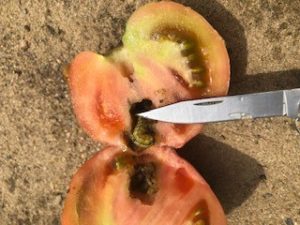
Your message has been sent
Tomato fruitworm was confirmed in a tomato field in Gloucester County on June 12th. Tomato growers should be applying insecticides to control this pest when monitoring for eggs and small larvae result in seeing any signs of worm activity. There is no economic threshold for tomato fruitworm. When control is needed, it is essential to treat before large numbers of larvae enter fruit, where they are protected from sprays.
When there is fruit present, the tomato fruitworm will complete its larval development inside fruit. Early stage larvae enter the stem end of fruit when it is between 0.75 to 2 inches in diameter. During development, caterpillars may emerge from one fruit and enter another. Their feeding results in a messy, watery, internal cavity filled with cast skins and feces. Damaged fruit will ripen prematurely. Small larvae are difficult to detect and, thus, may be a problem to find. Any amount of feeding results in unmarketable fruit that will need to be culled at harvest or in the packing shed.
For insecticide recommendations see the 2019 Mid-Atlantic Commercial Vegetable Production Recommendations: https://njaes.rutgers.edu/pubs/commercial-veg-rec/tomatoes.pdf

